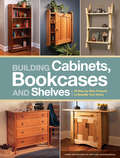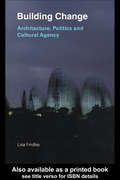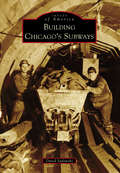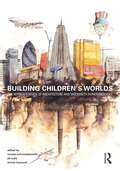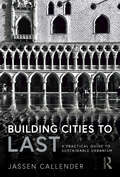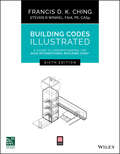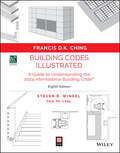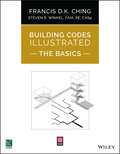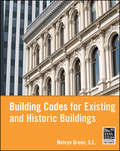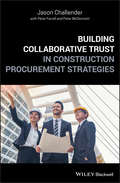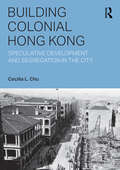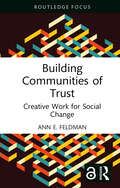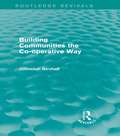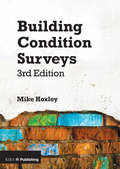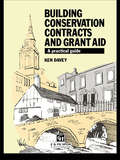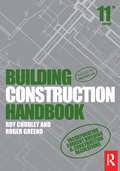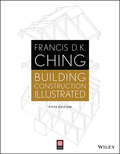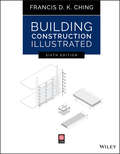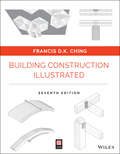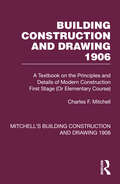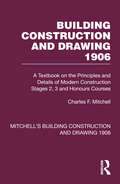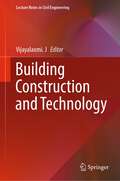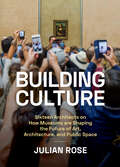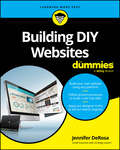- Table View
- List View
Building Cabinets, Bookcases and Shelves: 29 Step-by-Step Projects to Beautify Your Home
by Popular WoodworkingWhether you need storage for books, DVDs, games or clothes, you'll find attractive, custom options in this book. Open shelving? An enclosed cabinet? A classic bookcase? They're all here. Building Bookcases, Cabinets and Shelves offers 29 storage solutions in a variety of styles and sizes with both open and enclosed storage. Each project includes cutting lists, step-by-step instructions and tips and advice from professional woodworkers who have made each piece. Best of all, you can build them just as they are, or customize further to make each piece uniquely yours.
Building Change: Architecture, Politics and Cultural Agency
by Lisa FindleyBuilding Change investigates the shifting relationships between power, space and architecture in a world where a number of subjected people are reasserting their political and cultural agency. To explore these changes, the book describes and analyzes four recent building projects embedded in complex and diverse historical, political, cultural and spatial circumstances. The projects yield a range of insights for revitalizing the role of architecture as an engaged cultural and spatial practice.
Building Children’s Worlds: The Representation of Architecture and Modernity in Picturebooks
by Torsten Schmiedeknecht Jill Rudd Emma HaywardChildren are the future architects, clients and users of our buildings. The kinds of architectural worlds they are exposed to in picturebooks during their formative years may be assumed to influence how they regard such architecture as adults. Contemporary urban environments the world over represent the various stages of modernism in architecture. This book reads that history through picturebooks and considers the kinds of national identities and histories they construct. Twelve specialist essays from international scholars address questions such as: Is modern architecture used to construct specific narratives of childhood? Is it taken to support ‘negative’ narratives of alienation on the one hand and ‘positive’ narratives of happiness on the other? Do images of modern architecture support ideas of ‘community’? Reinforce ‘family values’? If so, what kinds of architecture, community and family? How is modern architecture placed vis-à-vis the promotion of diversity (ethnic, religious, gender etc.)? How might the use of architecture in comic strips or the presence of specific kinds of building in fiction aimed at younger adults be related to the groundwork laid in picturebooks for younger readers? This book reveals what stories are told about modern architecture and shows how those stories affect future attitudes towards and expectations of the built environment.
Building Cities to LAST: A Practical Guide to Sustainable Urbanism
by Jassen CallenderBuilding Cities to LAST presents the myriad issues of sustainable urbanism in a clear and concise system, and supports holistic thinking about sustainable development in urban environments by providing four broad measures of urban sustainability that differ radically from other, less long-lived patterns: these are Lifecycle, Aesthetics, Scale, and Technology (LAST). This framework for understanding the relationship between these four measures and the essential types of infrastructure—grouped according to the basic human needs of Food, Shelter, Mobility, and Water—is laid out in a simple and easy-to-understand format. These broad measures and infrastructures address the city as a whole and as a recognizable pattern of human activity and, in turn, increase the ability of cities—and the human race—to LAST. This book will find wide readership particularly among students and young practitioners in architecture, urban planning, and landscape architecture.
Building Codes Illustrated: A Guide to Understanding the 2018 International Building Code (Building Codes Illustrated #9)
by Francis D. Ching Steven R. WinkelTHE BESTSELLING, FULLY ILLUSTRATED GUIDE TO THE 2018 INTERNATIONAL BUILDING CODE Uniquely marrying the graphic skills of bestselling author Francis D.K Ching with the code expertise of Steven Winkel, FAIA, the new sixth edition of Building Codes Illustrated is a clear, concise, and easy-to-use visual guide to the International Building Code (IBC) for 2018. Fully updated throughout, it highlights all of the changes to the code for quick reference and easy navigation. It pulls out the portions of the building code that are most relevant for the architect and provides an easy-to-understand interpretation in both words and illustrations. The first two chapters of Building Codes Illustrated: A Guide to Understanding the 2018 International Building Code, Sixth Edition give background and context regarding the development, organization, and use of the IBC. The following sections cover such information as: use and occupancy; building heights and areas; types of construction; fire-resistive construction; interior finishes; means of egress; accessibility; energy efficiency; roof assemblies; structural provisions; special inspections and tests; soils and foundations; building materials and systems; and more. A complete, user-friendly guide to code-compliant projects Highlights all the significant changes in the 2018 IBC Uses clear language and Frank Ching's distinctive illustrations to demystify the 2018 International Build Code (IBC) text Provides students and professionals with a fundamental understanding of IBC development, interpretation, and application Building Codes Illustrated: A Guide to Understanding the 2018 International Building Code gives students and professionals in architecture, interior design, construction, and engineering a user-friendly, easy-to-use guide to the fundamentals of the 2018 IBC.
Building Codes Illustrated: A Guide to Understanding the 2021 International Building Code (Building Codes Illustrated)
by Francis D. Ching Steven R. WinkelBUILDING CODES ILLUSTRATED STAY INFORMED OF THE LATEST UPDATES TO THE INTERNATIONAL BUILDING CODE WITH THE LEADING VISUAL REFERENCE In the newly revised Seventh Edition of Building Codes Illustrated: A Guide to Understanding the 2021 International Building Code®, architectural drawing expert Francis D.K. Ching and well known architect Steven R. Winkel deliver a beautifully illustrated and intuitively written handbook for the 2021 International Building Code (IBC). The authors provide brand new chapters on plumbing fixture counts, elevators, special construction, and existing buildings while updating the remainder of the material to align with recent changes to the IBC. Easy to navigate and perfect as a quick-reference guide to the IBC, Building Codes Illustrated is a valuable visual resource for emerging professionals. The book also includes: Thorough introductions to navigating the Code, use and occupancy, special uses and occupancies, and building heights and areas Full explorations of the types of construction, fire resistive construction, interior finishes, fire-protection systems, and means of egress Practical discussions of accessibility, interior environment, exterior walls, roof assemblies, and structural provisions In-depth examinations of special inspections and tests, soils and foundations, building materials and systems, and elevators Perfect for students of architecture, interior design, construction, and engineering, the latest edition of Building Codes Illustrated is also ideal for professionals in these fields seeking an up-to-date reference on the 2021 International Building Code.
Building Codes Illustrated: A Guide to Understanding the 2024 International Building Code (Building Codes Illustrated)
by Francis D. Ching Steven R. WinkelSTAY INFORMED OF THE LATEST UPDATES TO THE INTERNATIONAL BUILDING CODE WITH THE LEADING VISUAL REFERENCE In the newly revised Eighth Edition of Building Codes Illustrated: A Guide to Understanding the 2024 International Building Code®, architectural drawing expert Francis D.K. Ching and well-known architect Steven R. Winkel deliver a beautifully illustrated and intuitively written handbook for the 2024 International Building Code (IBC). The authors provide updated material in all the chapters to align with the code changes in the new 2024 International Building Code (IBC). Easy to navigate and perfect as a quick-reference guide to the IBC, Building Codes Illustrated is a valuable visual resource for emerging professionals. The book also includes: Thorough introductions to navigating the Code, use and occupancy, special uses and occupancies, and building heights and areasFull explorations of the types of construction, fire resistive construction, interior finishes, fire-protection systems, and means of egressPractical discussions of accessibility, interior environment, exterior walls, roof assemblies, and structural provisionsIn-depth examinations of special inspections and tests, soils and foundations, building materials and systems, and elevators Perfect for students of architecture, interior design, construction, and engineering, the latest edition of Building Codes Illustrated is also ideal for professionals in these fields seeking an up-to-date reference on the 2024 International Building Code.
Building Codes Illustrated: The Basics (Building Codes Illustrated)
by Francis D. Ching Steven R. WinkelA visual introduction to the fundamentals of the 2021 International Building Code In Building Codes Illustrated: The Basics, architectural illustration expert Francis D.K. Ching and California architect and engineer Steven R. Winkel deliver a concise visual introduction to the 2021 International Building Code (IBC) distilled from the industry bestseller Building Codes Illustrated. With clear language and Frank Ching's distinctive illustrations, the book offers readers a sound understanding of the foundations of the IBC. The authors cover only the most relevant topics, and have designed this book to serve as a companion textbook for students taking introductory courses. Building Codes Illustrated: The Basics is also an essential study resource for the Codes and Regulations section of the Architect Registration Exam developed by NCARB. This book also provides: A solid understanding of the fundamentals of the 2021 International Building Code for students without a background in architecture or engineering Intuitive and memorable study material for people seeking licensure via the Architect Registration Exam Visually striking and memorable material designed to catch the reader's eye, hold attention, and improve retention Perfect for undergraduate students in 2- to 4-year courses studying building codes and specifications, Building Codes Illustrated: The Basics is also ideal for early-career professionals in architecture, interior design, construction management, and engineering.
Building Codes for Existing and Historic Buildings
by Melvyn GreenLearn to apply the International Building Code and International Existing Building Code to historic buildingsWritten for architects, engineers, preservation, and code enforcement professionals, this is the only comprehensive book that examines how the International Building Code (IBC) and the International Existing Building Code (IEBC) can be applied to historic and existing buildings. For ease of use, the book is organized to parallel the structure of the IEBC itself, and the approach is cumulative, with the objective of promoting an understanding of the art of applying building regulations to the environment of existing buildings. Building Codes for Existing and Historic Buildings begins with a discussion of the history of building regulations in the United States and the events and conditions that created them. Next, it provides thorough coverage of: The rationale behind code provisions and historic preservation principles Major building code requirements: occupancy and use, types of construction, and heights and areas Building performance characteristics: fire and life safety, structural safety, health and hygiene, accident prevention, accessibility, and energy conservation Case study projects that reinforce the material coveredAdditionally, the book includes building analysis worksheets-both blank and filled-in versions with examples-that illustrate how to develop a code approach for an individual building. If you are a professional at any level who is working on creating a plan that meets the intent of the code for historic or existing buildings, Building Codes for Existing and Historic Buildings gives you everything that you need to succeed.
Building Collaborative Trust in Construction Procurement Strategies: A Practical Guide
by Peter Farrell Jason Challender Peter McDermottProvides a practical framework and toolkit for improved construction project outcomes based on trust and collaboration This book explores the concept of trust as a tool in improved construction procurement strategies, and provides important insight into the influence of trust on the success of construction projects and redevelopment programs. It is a practical guide that offers readers a solid outline and expert strategies for improving project outcomes through collaboration—ultimately proving that teamwork can really make the dream work. Building Collaborative Trust in Construction Procurement Strategies: A Practical Guide incorporates a toolkit, complete with flowcharts, to introduce certain trust building interventions within projects. It shows how initiatives and factors that influence collaborative trust can be easily implemented and embedded in construction management for improved practice. It also covers potential challenges, risks, problems, and barriers when it comes to trust. In addition, the book looks at the influences for collaborative trust in the construction industry as well as implications in practice for it in construction. It finishes by looking at the future of collaborative trust in construction procurement. Teaches the importance and influence of trust on collaborative working and partnerships principles Examines to what extent trust within collaborative working arrangements influences the success of collaborative working practices Covers the effect that certain factors and trust building mechanisms have on collaborative working and partnerships and how they can be embedded into procurement of projects Discusses what constitutes best practice and how trust in collaborative procurement practices influences the success of construction projects Building Collaborative Trust in Construction Procurement Strategies: A Practical Guide is an excellent book for construction management professionals, including clients, consultants, and contractors. It will also serve as a helpful text for undergraduate and postgraduate students and academics.
Building Colonial Hong Kong: Speculative Development and Segregation in the City (Planning, History and Environment Series)
by Cecilia L. ChuIn the 1880s, Hong Kong was a booming colonial entrepôt, with many European, especially British, residents living in palatial mansions in the Mid-Levels and at the Peak. But it was also a ruthless migrant city where Chinese workers shared bedspaces in the crowded tenements of Taipingshan. Despite persistent inequality, Hong Kong never ceased to attract different classes of sojourners and immigrants, who strived to advance their social standing by accumulating wealth, especially through land and property speculation. In this engaging and extensively illustrated book, Cecilia L. Chu retells the ‘Hong Kong story’ by tracing the emergence of its ‘speculative landscape’ from the late nineteenth to the early decades of the twentieth century. Through a number of pivotal case studies, she highlights the contradictory logic of colonial urban development: the encouragement of native investment that supported a laissez-faire housing market, versus the imperative to segregate the populations in a hierarchical, colonial spatial order. Crucially, she shows that the production of Hong Kong’s urban landscapes was not a top-down process, but one that evolved through ongoing negotiations between different constituencies with vested interests in property. Further, her study reveals that the built environment was key to generating and attaining individual and collective aspirations in a racially divided, highly unequal, but nevertheless upwardly mobile, modernizing colonial city.
Building Communities of Trust: Creative Work for Social Change (Routledge Focus on Media and Cultural Studies)
by Ann E. FeldmanDrawing upon a combination of ethnographic research and media and communication theory, Building Communities of Trust: Creative Work for Social Change offers pathways to building trust in a range of situations and communities. Ann Feldman presents rich examples from her own life and social-impact journey with nonprofit, Artistic Circles, along with supplemental case studies from interviews with 20 to 30-year-olds, to address how to create vibrant, trust-based societies and to determine what works and what doesn’t while advancing towards creating social impact. These case studies and shared experiences from real life media projects across 30 years, reveal behind-the-scenes stories of challenges, conflicts, and resolutions in global impact efforts ranging from women’s empowerment to water access. The book explains how the success – or failure – of social-impact initiatives depends on power struggles, funding, interpersonal misunderstandings, identity crises, fears, and stereotypes. The book’s goal is to help aspiring changemakers develop strategies for sustainable social-change projects. It serves as a guide for undergraduates, graduate students, and high-school upperclassmen in environmental studies, business, sociology, gender and sexuality, cross-cultural studies, music, religion, and communications and media.
Building Communities: The Co-operative Way (Routledge Revivals)
by Johnston BirchallBuilding Communities: The Co-Operative Way, first published in 1988, sets the flourishing of housing co-operatives throughout the 1980s in a theoretical and historical framework that suggests that tenant control is the best way out of the still-problematic issue of housing policy. Before the First World War, co-operative housing was poised to become a potent force in government policy, but instead municipal housing rose to prominence. However, alongside a growing crisis of confidence in state housing and a continued decline in the private rented sector, a new political consensus has emerged that has placed co-ops firmly at the top of the agenda. Setting out the argument for collective dweller-control of housing, Birchall demonstrates that the arguments for co-operatives are strong, based on a broad spectrum of political thought. He charts the early and recent history of co-operative housing, and shows how they provide a flexible and stable means of meeting housing needs.
Building Condition Surveys: A Practical and Concise Introduction
by Mike HoxleyCondition surveys are becoming increasingly important and standardised in approach but are a high risk service with the potential for legal consequences if mistakes are made. Professionals therefore require clear, up-to-date advice on how to inspect and report accurately and this book provides a one-stop shop of uniquely practical, concise and accessible guidance written by one of the leading authorities in the field. The key coverage includes: Domestic and commercial surveys; surveys for historic, new and dilapidated buildings Improvements to surveys including the inclusion of colour photographs, condition ratings, use of the term ‘technical due diligence’ and increased professionalization New techniques for further investigation including thermography, endoscopy and ground radar Advances in the diagnosis of causes of masonry cracking New hazards such as Japanese Knotweed Updated to reflect the latest RICS regulations, legislation and guidance on building surveying Case studies of both bad and good practice and images to illustrate real world problems and solutions
Building Conservation Contracts and Grant Aid: A practical guide
by Ken Davey K. DaveyThis book describes all the principal methods of arranging letting building contracts for conservation work. It also covers contractor selection, the use of directly employed labour, and contractual considerations.
Building Construction Handbook: Incorporating Current Building And Construction Regulations (Building Construction Handbook Ser.)
by Roy Chudley Roger GreenoIdeal for students on all construction courses Topics presented concisely in plain language and with clear drawings Updated to include revisions to Building and Construction regulations The Building Construction Handbook is THE authoritative reference for all construction students and professionals. Its detailed drawings clearly illustrate the construction of building elements, and have been an invaluable guide for builders since 1988. The principles and processes of construction are explained with the concepts of design included where appropriate. Extensive coverage of building construction practice, techniques, and regulations representing both traditional procedures and modern developments are included to provide the most comprehensive and easy to understand guide to building construction. This new edition has been updated to reflect recent changes to the building regulations, as well as new material on the latest technologies used in domestic construction. Building Construction Handbook is the essential, easy-to-use resource for undergraduate and vocational students on a wide range of courses including NVQ and BTEC National, through to Higher National Certificate and Diploma, to Foundation and three-year Degree level. It is also a useful practical reference for building designers, contractors and others engaged in the construction industry.
Building Construction Illustrated
by Francis D. ChingThe classic visual guide to the basics of building construction, now with a 3D digital building model for interactive learningFor over three decades, Building Construction Illustrated has offered an outstanding introduction to the principles of building construction. This new edition of the revered classic remains as relevant as ever, providing the latest information in Francis D.K. Ching's signature style. Its rich and comprehensive approach clearly presents all of the basic concepts underlying building construction. New to this edition are digital enhancements delivered as an online companion to the print edition and also embedded in e-book editions. Features include a 3D model showing how building components come together in a final project.llustrated throughout with clear and accurate drawings that present the state of the art in construction processes and materialsUpdated and revised to include the latest knowledge on sustainability, incorporation of building systems, and use of new materialsContains archetypal drawings that offer clear inspiration for designers and draftersReflects the 2012 International Building Codes and 2012 LEED systemThis new edition of Building Construction Illustrated remains as relevant as ever, with the most current knowledge presented in a rich and comprehensive manner that does not disappoint.
Building Construction Illustrated
by Francis D. ChingThe #1 visual guide to building construction principles, updated with the latest materials, methods, and systems For over four decades, Building Construction Illustrated has been the leading visual guide to the principles of building construction. Filled with rich illustrations and in-depth content by renowned author Francis D.K. Ching, it offers students and practicing professionals the information needed to understand concepts in residential and commercial construction, architecture, and structural engineering. This Sixth Edition of Building Construction Illustrated has been revised throughout to reflect the latest advancements in building design, materials, and systems, including resilient design, diagrids, modular foundation systems, smart façade systems, lighting sources, mass timber materials, and more. It features new illustrations and updated information on sustainability and green building, insulation materials, and fire-rated wall and floor assemblies. This respected, industry standard guide remains as relevant as ever, providing the latest in codes and standards requirements, including IBC, LEED, and CSI MasterFormat. This Sixth Edition: The leading illustrated guide to building construction fundamentals, written and detailed in Frank Ching's signature, illustrative style Includes all new sections on resilient design; diagrids; modular foundation systems; smart façade types and systems; lighting sources and systems; and mass timber materials, cross laminated timber (CLT) and nail laminated timber (NLT) Revised to reflect that latest updates in codes and standards requirements: 2018 International Building Code (IBC), LEED v4, and CSI MasterFormat 2018 Includes updated information on sustainability and green building; insulation materials; stair uses; stoves and inserts; and fire-rated wall and floor assemblies Offers instructors access to an Instructor's Manual with review questions Building Construction Illustrated, Sixth Edition is an excellent book for students in architecture, civil and structural engineering, construction management, and interior design programs. Ching communicates these core principles of building construction in a way that resonates with those beginning their education and those well into their careers looking to brush up on the basics. Building Construction Illustrated is a reliable, lifelong guide that practicing architects, engineers, construction managers, and interior designers, will turn to time and again throughout their careers.
Building Construction Illustrated
by Francis D. ChingThe leading introduction to the principles and processes of building construction returns Building construction covers the entire process of creating residential, commercial, and industrial structures, from planning to execution. It's an evolving field, with new technologies continuously being brought to bear and new sustainable practices emerging every day. For over four decades, Building Construction Illustrated has served as the leading introduction to building construction for all professionals involved in the process, from architects to interior designers. Richly illustrated and incorporating the latest advancements and best practices, it remains the essential volume for students and working professionals alike. Readers of the seventh edition of Building Construction Illustrated will also find: New or expanded coverage of resilient design, building systems, new finish materials, and more The latest updates to codes and standards requirements including IBC, LEED, and CSI MasterFormat In-depth yet accessible treatment appropriate for all levels of prior knowledge Building Construction Illustrated is ideal for students in architecture, civil and structural engineering, construction management, and interior design, as well as practicing professionals across the building trades.
Building Construction and Drawing 1906: A Textbook on the Principles and Details of Modern Construction First Stage (Or Elementary Course) (Mitchell's Building Construction and Drawing)
by Charles F. MitchellOriginally published in 1881, but here reissuing the 1906 edition with a new introduction by Stephen J. Scaysbrook, the Mitchell Building and Construction books offer an unparalleled insight into construction techniques and materials. Originally written to provide a concise handbook and guide for students and for practitioners, this reissue of Mitchell’s 1906 First Stage or Elementary Course edition now provides a valuable addition to building pathology, allowing students and practitioners to research construction methods and materials pertinent to the period. Including over 1000 drawings, it is of no surprise to see Mitchell’s First Stage or Elementary edition start with a detailed explanation of the instruments and methods of drawing with pencil ink and tracing paper, emphasising the need to learn basic drawing skills and the need to think about a detail and the materials used to create a detail capable of lasting well over 100 years or more. The simple act of making a scale from a drawing with only one dimension may be lost to modern-day students, but not to Charles Mitchell, who describes the method and its use.
Building Construction and Drawing 1906: A Textbook on the Principles and Details of Modern Construction Stages 2, 3 and Honours Courses (Mitchell's Building Construction and Drawing)
by Charles F. MitchellOriginally published in 1881, but here reissuing the 1906 edition with a new introduction by Stephen J. Scaysbrook, the Mitchell’s Building and Construction Stage 2, 3 and Honours book offers an unparalleled insight into historic construction techniques and materials. Originally written to provide a concise handbook and guide for students and for practitioners, this reissue of Mitchell’s 1906 Advanced and Honours edition now provides a valuable addition to building pathology, allowing students and practitioners to research construction methods and materials pertinent to the period.
Building Construction and Technology (Lecture Notes in Civil Engineering #360)
by Vijayalaxmi J.This book highlights various aspects of building construction industry based on data from field studies. It discusses the challenges, methodologies, technological applications in building construction, technology, and management. The book presents new approaches to effective building construction and an understanding of the impact of applications of latest technologies. This book is aimed at researchers and professionals in civil engineering and building engineering management to assist in understanding the domain along with recent applications, the advantages, and practical limitations through real-life case studies. This book is useful for building engineers in understanding the effective use of technology, construction methods, and project delivery systems.
Building Culture: How Museums are Shaping the Future of Art, Architecture, and Public Space
by Julian RoseAn insider's look at art museums and how they shape the ways we view art, through the eyes of the architects who design them.Architects and art lovers everywhere will enjoy this remarkable collection of interviews from sixteen of the world's most celebrated, thoughtful, and innovative architects who have designed many of the world’s greatest museums. Spanning generations, geographies, and methods of architectural practice, these architects share the complex and fascinating process of creating spaces for art. Building Culture includes interviews with:Frank Gehry, who reveals how a half-century of dialogue with the visual arts influenced his revolutionary Guggenheim Bilbao.Kulapat Yantrasast, who describes his rethinking of exhibition design and how it expands the presentation of work in venerable institutions like the Metropolitan Museum of Art, where he is currently redesigning the galleries for the arts of Africa, Oceania, and the Americas.Walter Hood, whose long interest in improvisational techniques in music informed his design for outdoor performance spaces in the Oakland Museum.Elizabeth Diller, whose conception of the Shed in New York City's Hudson Yards was influenced by decades of work in conceptual and performance art.Esteemed architects who have designed, renovated, or created galleries for MoMA, the New Museum, and the American Museum of Natural History in New York; the National Gallery and the Tate Modern in London; the Pérez Art Museum Miami; the Centre Pompidou in Paris, the 21st Century Museum of Contemporary Art, Kanazawa in Japan; the Museum of West African Art (currently under construction) in Nigeria; and many others. This lively compendium reveals intensely varied architectural philosophies from a diverse group of established and up-and-coming professionals. Engaging personal recollections of relationships with artists and curators, along with 80 captivating images, provide further insight into the design process and timeless inspiration for architecture students, artists, museum professionals, and anyone fascinated by architectural design, public space, and museum culture.
Building DIY Websites For Dummies
by Jennifer DeRosaCreate an attractive website that draws in visitors – no coding required! There’s more to building a website than just picking a theme and dropping in text and images. Creating a site that attracts visitors and turns those visitors into customers requires some professional insight and a few tips and tricks. Building DIY Websites For Dummies guides non-designers through the steps of creating an attractive and effective website using today’s top web-based tools. This book helps you launch or improve your website designed to boost your entrepreneurial endeavors, small business, or personal passion. With this easy-to-follow Dummies guide, you can skip learning the complicated coding that runs a site and focus on the parts that attract visitors (and search engines). Grab this book and get expert insight on how to craft a usable design, create site content, improve site findability, and convert browsers into buyers. Discover how to select hosting services, email providers, and beginner-friendly website creators Build your own website without needing to learn any code Learn how to create an attractive design, develop content, and present it all in a way that will appeal to your target audience Improve your site’s search engine findability and resonate with your target customer This Dummies guide is an excellent choice for non-designers who want to create a website without hiring someone to do it for them. Learn the ropes, follow the best practices, and launch your site!
